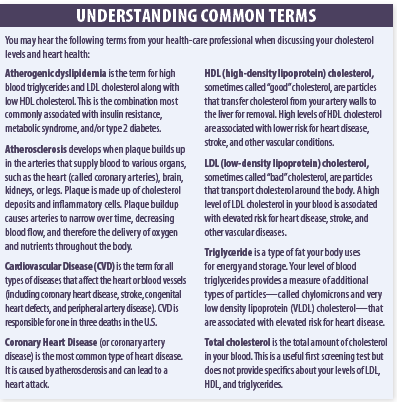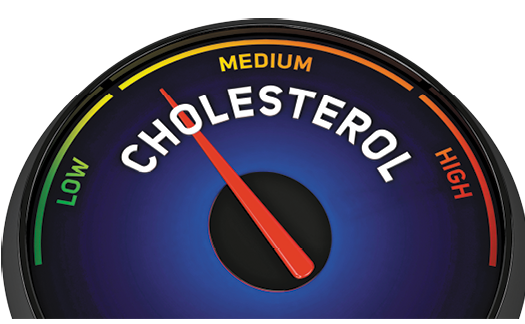According to the National Institutes of Health, heart disease is the number one killer of both men and women in the United States. High levels of certain types of cholesterol in your blood increase your risk for heart disease–and the higher your cholesterol levels, the greater your risk. Each year, more than a million Americans suffer a heart attack, and about a half million die from heart disease. This Valentine’s Day, take care of your heart by committing to managing your cholesterol levels.
The Good and the Bad. “There are different kinds of cholesterol-carrying particles circulating in your blood stream,” says Alice H. Lichtenstein, DSc, director of the Cardiovascular Nutrition Laboratory at the Human Nutrition Research Center on Aging and executive editor of this newsletter. “One type is low-density lipoprotein (LDL) cholesterol. High levels of LDL cholesterol can lead to a buildup of plaque on the walls of arteries, causing narrowing. This narrowing diminishes blood flow. If this happens to arteries that nourish heart muscle, it can cause chest pain (angina). If blood flow is blocked due to plaque buildup or a blood clot triggered by the plaque, it can cause a heart attack. A clogged artery that flows to the brain causes the most common type of stroke, termed ischemic stroke, and also increases risk of dementia. Clogged arteries to other organs can lead to reduced kidney function, and reduced exercise capacity in your legs. LDL cholesterol is therefore referred to as ‘bad’ cholesterol.”
High-density lipoprotein (HDL) cholesterol is called “good” cholesterol. HDL particles return cholesterol from the artery walls back to the liver to be removed from the body. “Lowering LDL cholesterol can reduce cardiovascular disease (CVD) risk,” says Dariush Mozaffarian, MD, DrPH, a cardiologist, dean of policy for the Friedman School, and editor-in-chief of this newsletter, “and so might raising HDL cholesterol levels, especially if achieved through healthier lifestyle,” The only way to determine your blood cholesterol levels is to have a blood test. Taking steps to lower blood LDL cholesterol levels reduces your risk of developing heart disease and, if you already have heart disease, your risk of the disease progressing.
➧ Make healthy eating choices. Choose minimally processed fruits, vegetables, nuts/seeds, whole grains, beans/lentils, seafood, and non-tropical plant oils in place of red meats, processed meats, butter, lard, palm oil, and refined breads, crackers, cookies, and cakes.
➧ Decrease excess body fat. Commit to positive behavior changes that shift you toward a healthier dietary pattern and be more physically active. Work with your health-care provider or a registered dietitian on a plan to help you reach and maintain a healthy weight.
➧ Get moving. Physical activity has a positive effect on cholesterol levels. Every bit of extra activity you add to your day helps.
➧ Don’t Smoke. Don’t start smoking or vaping, and if you do smoke, seek help quitting. There are several effective treatments to help you stop—talk to your doctor or other health-care provider.
➧ Make a plan. If you are told you have high LDL cholesterol levels, ask your health-care provider about what approaches you can take to lower it. Take medication as prescribed and adopt healthy lifestyle choices.
What You Can Do. Risk factors for higher LDL cholesterol include genetics, male sex, being middle aged, a sedentary lifestyle, smoking, and—importantly—diet. While we can’t control our genes, sex, and age, we can control our lifestyle choices.
What you eat (and don’t eat) can meaningfully change your blood cholesterol levels. “People who eat more saturated fat from red meats and less healthy unsaturated fats, dietary fiber, and phytosterols from plant sources are more likely to have high LDL levels,” says Mozaffarian. To reduce LDL cholesterol and increase HDL cholesterol levels, the major focus should be on replacing saturated fats from red meats, processed meats, butter, lard, and palm oils with healthy unsaturated fats from plant sources like nuts, seeds, plant oils (olive, canola, peanut, sunflower, etc.), and avocadoes and increasing dietary fiber from fruits, vegetables, beans, and whole grains. Plant foods also provide beneficial phytosterols (plant compounds structurally similar to cholesterol).
Interestingly, while the saturated fat in red and processed meats is associated with heart disease risk, the saturated fat in dairy foods is not. “It’s not fully clear why saturated fat from red meat versus dairy may have different health effects,” says Mozaffarian. “Possibilities include differences in the types of saturated fat (dairy foods contain more medium chain triglycerides) or in other nutrients or characteristics (for example, red meat contains heme iron, which may be harmful at high levels, while cheese and yogurt are fermented foods, which may have some health benefits).” More research is needed on these questions.
For the best chance at avoiding cardiovascular disease, you should also take steps to not smoke, control type 2 diabetes and high blood pressure, lose extra body fat, and be more active (see Take Charge! box for more information). If healthy lifestyle choices are not enough to get your cholesterol levels to a desirable range, work with your health-care provider to find a medication that is right for you. Your heart will thank you!

























